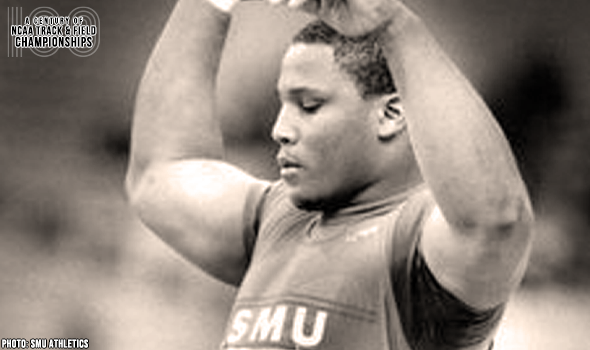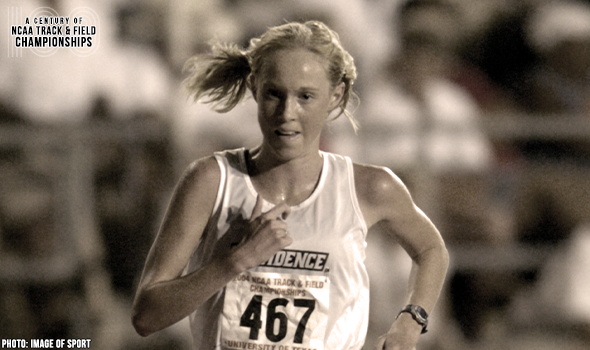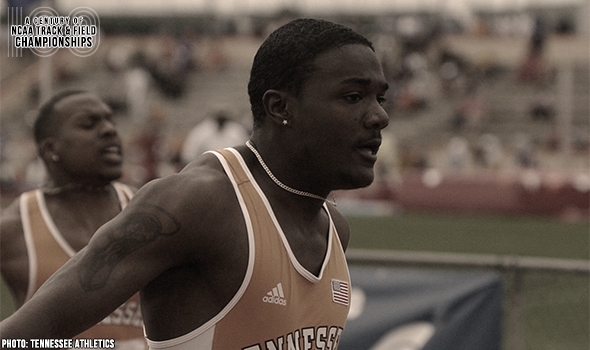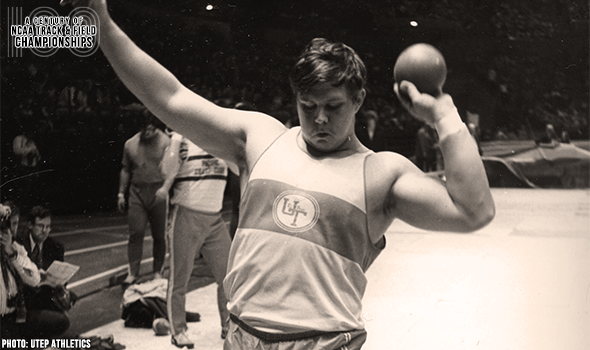
Carter’s Shot Put Prowess Was Legendary
In January 1983, Michael Carter of SMU picked up a shot for the first time in 18 months.
By June of that same year, he was looking to regain the national title in that event at the NCAA Division I Outdoor Track & Field Championships in Houston.
Carter – who had won in 1980 and 1981 – wasn’t able to try for a third in 1982 when he missed the entire indoor and outdoor seasons recovering from a football injury he suffered in October 1981. He was the starting nose tackle for the Mustangs, who were undefeated in 1982 and only lost one game in 1981.
After the cast on Carter’s right knee came off in January 1982, Carter showed his competitive side, telling John Eisenberg of the Dallas Times-Herald: “As soon as I get the go-ahead, I’m going to bust my butt like I never did before. I’m going to make my legs stronger than they ever have been.”
Meanwhile, another strong throwing figure emerged in 1982 with Carter’s absence – Oregon’s Dean Crouser, who not only won the NCAA shot that year but the discus as well. And the day before the 1983 NCAA shot final, Crouser looked great, repeating his discus win with a meet-record 65.88m (216-2) while Carter was 10th (Carter placed runner-up two years earlier in 1981).
Carter made this shot final his from the beginning. He took the immediate lead with a 20.22m (66-4¼) effort in Round 1 and then followed with the winning have of 20.90m (68-7) – his best since a pre-injury 21.25m (69-8¾) that set an NCAA Indoor meet record in 1981. Crouser, the defending champion, finished third behind John Brenner of UCLA.
As it turns out, Carter’s points were crucial to SMU, which eked out a two-point victory over Tennessee to complete a sweep of indoor and outdoor team crowns.
“I knew in the back of my mind that Crouser could hit a big one at any time,” Carter said after the meet. “I tried to improve after the second throw, but I couldn’t. I wanted to keep my string alive; my goal is eight straight.”
At this point, Carter had six national titles in the shot put – three each indoor and outdoor. He got to seven with his indoor victory in 1984, but his attempt for eight was part of an epic duel with Brenner that will be the subject of its own forthcoming moment in this series.
Alas for track & field fans, Carter’s last shot put competition came when he earned the silver medal at the Los Angeles Olympics. He then joined the NFL’s San Francisco 49ers, with whom he was part of three Super Bowl champion teams.
Michael’s two daughters also won NCAA titles – Michelle (Texas), the 2006 indoor shot put champion; D’Andra (Texas Tech), the 2009 discus champion – making the Carters the first family with three NCAA Division I track & field champions. In 2016, Michelle earned the family’s first Olympic gold medal, also becoming the first American woman to win the shot put.
The NCAA and collegiate track & field will mark a momentous milestone in the spring of 2021 -- the 100th anniversary of the NCAA Championships and with that, the NCAA Track & Field Championships. In June 1921, the University of Chicago hosted the first track & field championships in NCAA history.
This point can’t be emphasized enough: Not only was the event the first for NCAA track & field, but the first championships for any sport under the sponsorship of the NCAA.
To celebrate, over each of the next 365 days, the U.S. Track & Field and Cross Country Coaches Association (USTFCCCA) will celebrate moments, student-athletes, and coaches that have made a century’s worth of championships special. From humble beginnings to important historical milestones to the modern-day, collegiate track & field has evolved with the American society.
The 2021 edition of the NCAA Division I Outdoor Track & Field Championships begin with preliminary round action on May 27-29 in Jacksonville, Fla., and College Station, Texas. The championships final site and culmination of the celebration is slated for June 9-12, 2021 at the newly rebuilt Hayward Field in Eugene, Ore.

Providence’s Smith Left Field In The Dust
Kim Smith won the 5000 meters at the 2004 NCAA Division I Outdoor T&F Championships by 36.04 seconds in 15:48.86 for the largest margin of victory in meet history.

Gatlin Doubled Up In Back-To-Back Years
Justin Gatlin completed back-to-back 100-200 doubles at the NCAA DI Outdoor T&F Championships in 2001 & 2002. He went 10.08/20.11 & 10.22/20.18 in those respective years.

UTEP’s Hoglund First To Crack 70-Foot Barrier
Hans Hoglund was the first man to touch the 70-foot barrier in the SP at the NCAA DI Outdoor T&F Championships. He also won by more than 4 feet with his 21.33m (70-0) heave in 1975.

LSU’s Hobbs Couldn’t Be Caught In 2018
Aleia Hobbs anchored LSU to a 4×100 relay MR of 42.25 & then doubled back to win the 100 by 0.23 seconds at the 2018 NCAA DI Outdoor T&F Championships.

Michael Johnson Had 1990 NCAAs To Remember
All eyes were on Michael Johnson of Baylor in the 4×400-meter relay at the 1990 NCAA Division I Outdoor Track & Field Championships.

Riley Completed Unprecedented Double In 2012
Andrew Riley completed the only 100-110H double in NCAA DI Outdoor T&F Championships history in 2012. Riley won the 100 in 10.27 & then captured the 110H crown in 13.53

Leatherwood Rolled To Back-To-Back 400 Titles
Lillie Leatherwood won back-to-back 400-meter titles at the NCAA Division I Outdoor T&F Championships in 1986 & 1987. She set a meet record of 50.90 in that second year.

Iowa’s Jones Made Distance History
Charles “Deacon” Jones set a meet record in the 2-mile at the 1957 NCAA Outdoor Track & Field Championships with his time of 8:57.6.

Locke Doubled Up On Sprint Titles In 1926
Roland Locke entered the 1926 NCAA Outdoor T&F Championships as the WR holder in the 220. He left with the meet record in that event (20.9) & also won the 100 in 9.9.

McLain Bounded To All-Conditions TJ Best
Erica McLain won the triple jump at the 2008 NCAA DI Outdoor Track & Field Championships by nearly two feet! McLain bounded to an all-conditions meet best at 14.60m (47-11).

